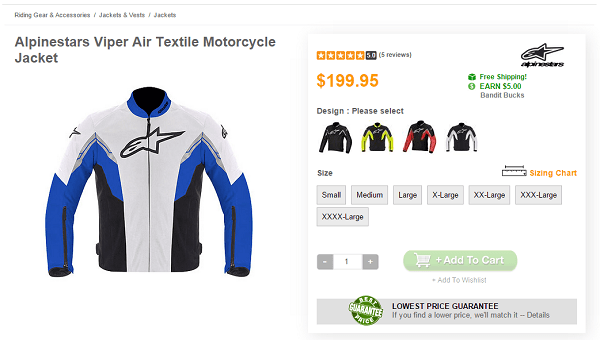Anyone can throw up an ecommerce site these days; pay the right people for the right set of services and you’re ready to go. Running a profitable ecommerce site is tough. Competition is stiff, and many details that keep the best at the top aren’t readily shared.
Our philosophy is different. We believe that helping fellow entrepreneurs should be the norm. That’s why we’re here, dishing out content that will help you grow your business. Today, the focus is optimizing your ecommerce site for search engines.
Product Descriptions and Images
Do your product descriptions on your web store sound like your company and your brand? There’s an epidemic of copycat content out there, and when it comes to your business, the last thing you want to be is a predictable cut out.
Always avoid using product descriptions from manufacturers. Use them as inspiration, sure, but the time you’ll save copying-and-pasting will do absolutely nothing for your page’s long-term SEO value. Think about it this way: How many other people use the exact content provided by manufacturers? You want your description to be unique and search engine friendly — something that manufacturers don’t think about when writing content for products.
If you’re selling products that you create yourself, then you’re creating your descriptions from scratch. Do not, under any circumstance, copy content from other similar products being sold online; search engines will penalize you. Get creative and develop personalized content that persuades the reader to buy by describing benefits and avoiding features as much as possible.
Image search is a popular way to browse products. To make sure that your product images appear high in the rankings, use keyword driven alt tags. An alt tag is a text alternative for an image and will be read by search engines as an alternative to the image itself. Follow SEO best practices when developing alt tag content.
Product Reviews
Over 70% of online shoppers hunt for reviews before making a purchase. Displaying ratings and reviews on your ecommerce site is essential for ensuring that you aren’t losing traffic to other sites. And did you know that those reviews provide your site with dynamic SEO value?

Allowing buyers to rate your products directly on your site is also a great feature to have. You might consider integrating a comment/rating system from one of the big players (Amazon, Google, Yelp) to get as much as you can out of raving reviews.
Reviews hold the secret sauce to SEO. Observe how your customers talk about your products. That is how you should be writing content. If you can incorporate questions that customers might ask, and the answers to those questions, in your product descriptions you will grab Google’s attention as a trusted source.
Make Usability and Design a Priority
Search engines have their own standards for usability that they use to rate websites; those standards revolve mostly around mobile friendliness. In early 2014, mobile usage surpassed PC usage. Companies like Google understand this eclipse to be the new standard and have created algorithms to support mobile’s development.
Have you ever used a mobile device to visit an online store that wasn’t optimized? You would know if you have. The interface is clunky, proper viewing requires pinching and scrolling, and selecting from a navigation bar is a nightmare. If usability isn’t a priority and you haven’t optimized your site to be mobile responsive, that’s the experience you’re providing to over 50% of your website visitors.
Do you know who hates mobile clunkiness even more than your visitors? Search engines!
“Speaking” URLs
No, they don’t actually talk; they mimic speech.
Speaking URLs are keyword friendly URLs that include a short description and/or product name in the site address. Say, for example, you’re shopping for a GoPro HERO4 Silver. Compare the two URLs below; which would you click?
- www.wesellcameras.com/J-l5GQIOa6lKvmet8w2V8TI/sOjqgH
- www.wesellcameras.com/gopro/hero4-silver
The first is a random assortment of numbers, letters and symbols that tell you nothing about the page. The second is an example of a speaking URL. Notice how it uses conversational language. This is a key addition that not only increases your page’s SEO value, but increases the chance that someone will click on your page from a web browser since they know exactly what they’re clicking into.
Another example of a speaking URL:
Changing your website’s URLs to speaking URLs is a simple adjustment, though keep in mind that Google’s spiders will return a 404 for your original URL unless you set up a 301 redirect. The redirect is the proper way to make this adjustment without losing any SEO value garnered by your original URL. Your web designer should be able to make this change without much trouble.
Home Page Optimization
If you want your website visitors to make a purchase, then it’s only logical to place your store as close to your home page as possible — one click away from your home page is ideal. The deeper your ecommerce store is (the more clicks it takes to access your store) the less value search engines will place on it. Also, the deeper your store is, the less likely visitors are to access it.
Every point in this article can be summed up with a simple sentence:
(TL:DR) Design your ecommerce business from your customers’ point of view, from product descriptions to optimizing your home page for usability; it all comes back to the customer.
Now SEO isn’t an overnight fix; search engine optimization takes months to take effect, and depending on your current rankings, it could be a longer process. That in no way means digital entrepreneurs should shuck the responsibility they have to help create a better online experience.
Truly, SEO reaches beyond all of us and attempts to build a better web. We’re all just playing along, and while we’re playing along, we might as well optimize our ecommerce sites to make a buck or two.